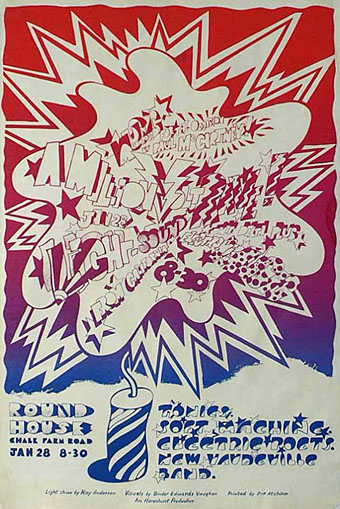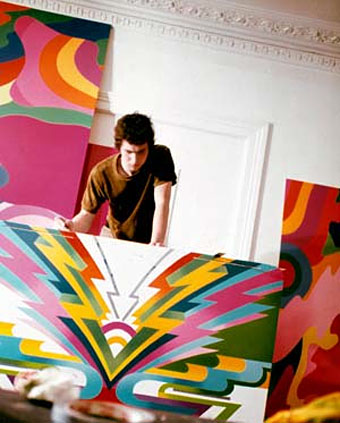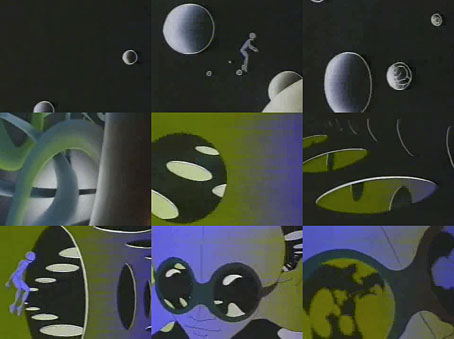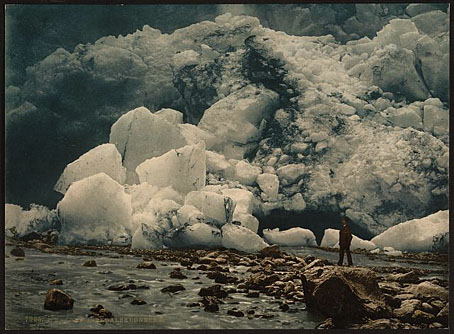On gospel, Abba and the death of the record: an audience with Brian Eno
Category: {electronica}
Electronic music
Autobahn animated
The Düsseldorf maestros are treated to some animated illustration in this 1979 film by Roger Mainwood which takes Kraftwerk’s Autobahn as its soundtrack. Mark at Strange Attractor provided the tip and he compares the animation style to René Laloux and Roland Topor’s Fantastic Planet (1973). The purple humanoid floating through surreal landscapes is certainly reminiscent of Laloux’s film, but Autobahn also reminds me of Bruno Bozzetto’s Allegro non troppo (1977) and, given that Mainwood’s animation comes a couple of years later, it may well have been inspired by it. Bozzetto’s film is a feature-length “adult” response to Walt Disney’s Fantasia which takes the Fantasia format—well-known classical themes illustrated by animated sequences—but does so in a slightly more grotesque or risqué fashion. Much of Bozzetto’s film seems less daring today than it was in 1977 but the best sequence still works well and happens to be as science fictional as Mainwood’s Autobahn, an entire cycle of planetary evolution set to Ravel’s Bolero. Follow the links below.
• Roger Mainwood’s Autobahn pt. 1 | pt. 2
• Ravel’s Bolero from Allegro non troppo
Previously on { feuilleton }
• Sleeve craft
• Who designed Vertigo #6360 620?
• Old music and old technology
• Aerodynamik by Kraftwerk
• The genius of Kraftwerk
Winter music
Kjendalskronebrae, Nordfjord, Norway (c. 1900). From the Library of Congress Prints and Photographs Division via Wood s Lot.
Are you suffering list fatigue yet? I certainly have been, especially from the apparently endless “best ___ of the decade” catalogues which would have you believe that the significant cultural products of the past ten years have been thoroughly sifted, reviewed and appraised. So yes, there’s a degree of hypocrisy in adding to the list surplus but, as with the Halloween music lists, it’s difficult to write about an area of listening without compiling something like this. As it happens, my Halloween playlists proved briefly popular this year when they were noticed by Stumbleupon users so someone appreciates them.
The present selection is music to complement the season and its chilly weather which in our part of the world has been colder than usual and laden with snow. It might also serve as a suggested alternative to the dreary plague of Christmas songs. This isn’t definitive, of course, and I could have added more than ten. I kept the choices in the electronic spectrum but there’s a whole other list which could be made of winter-themed folk songs, folk music of all kinds being sensitive to the changing seasons.
Sonic Seasonings (1972) by Wendy Carlos.
Between her electronic transcriptions of Baroque music and the score for A Clockwork Orange, Wendy Carlos released a collection of four long pieces of electronic atmospherics blended with natural sound recordings, with each track dedicated to a different season. The album may not have had the formal intent of Brian Eno’s ambient albums but ambient it certainly is, preceding Eno’s Discreet Music by three years whilst predicting much of what would become over-familiar during the 1990s. The Winter track is the one which concerns us here, a droning Moog landscape of echoed notes, tinkling ice, distant wind and Rachel Elkind’s lupine howls. Carlos and Elkind carried the synthesised chill into their opening music for The Shining a few years later, and Carlos returned to the theme with the digital improvisations of Land of the Midnight Sun, included as a bonus on the Sonic Seasonings CD.
Eskimo (1979) by The Residents.
A conceptual masterpiece, and an album which still sounds as strange and timeless as it did when it first appeared. Eskimo is the first and (one presumes) only example of what might be labelled “Eskimo exotica” since the whole work is more Eskimo-esque than an authentic musical rendering of the world of the Inuit people. Like Wendy Carlos’s Winter, these are shifting soundscapes augmented by ritual chants and synthesised animal sounds. For those who found the album to be musically inaccessible the group released Diskomo, a segue of the musical themes matched to a thumping dance beat.
Iceland (1979) by Richard Pinhas.
Another far north concept album and the third solo release from the Heldon guitarist who subdues his Robert Fripp impersonations in favour of synth arrangements. The CD version includes a 22-minute bonus, Winter Music.
Victorialand (1986) by Cocteau Twins.
Much of the Cocteau Twins’ chiming and reverb-drenched output would suit the colder months but Victorialand in particular takes its title from a region of Antarctica, and many of the track titles—Whales Tails, How to Bring a Blush to the Snow—point in that direction. Another timeless work.
White Out (1990) by Johannes Schmoelling.
Schmoelling was a member of Tangerine Dream in what I consider to be their last worthwhile incarnation from 1980 to 1986. His third solo album also takes Antarctica as its theme and while some of the music tends to a jaunty blandness at its best it manages to evoke the isolation of the continent through lengthy synthesiser pieces. When the Polydor release went out of print, Schmoelling re-worked the album slightly for reissue on his own label.
Songs from the Cold Seas (1995) by Hector Zazou.
Many of the late Hector Zazou‘s albums were concepts of some kind, often involving a roster of guest artists. Songs from the Cold Seas follows this pattern with singers from around the world delivering a variety of songs from the world’s colder regions. For a contrast to the Residents’ ethnological forgeries, Song of the Water is a chant by Inuit artists Elisha Kilabuk and Koomoot Nooveya. Among other highlights there’s Björk who restrains her vocal gymnastics for once with a delicate Icelandic lullaby, Vísur Vatnsenda-Rósu.
Polar Sequences (1996) by Higher Intelligence Agency & Biosphere.
A collaboration between Bobby Bird of HIA and Biosphere‘s Geir Jenssen, recorded live with sounds sourced in and around Jenssen’s home town of Tromsø at the Arctic Circle. I much prefer this to the other HIA releases which lack its detailed textures. One track, Meltwater, sounds just as you’d expect, all running water and crackling ice.
Substrata (1997) by Biosphere.
Still one of the finest Biosphere releases (although Nordheim Transformed is probably my favourite) and included here for its chilly and mostly beatless atmosphere which includes further samples from the far north.
La Marche de L’Empereur (2005) by Emilie Simon.
I still haven’t seen La Marche de L’Empereur (March of the Penguins) but the soundtrack for the original French release is a fantastic collection of songs illustrating the survival struggles of the film’s penguins. Emilie Simon is frequently described as “the French Björk”, a lazy label which only connects the pair because they’re female singers who also happen to be “foreign” and users of unorthodox electronic arrangements. The recordings here feature glitch-inflected rhythms and glass instruments which means they were far too interesting for the American release of the film. The Hollywood version dropped the songs in favour of a traditional orchestral score.
Alaska Melting (2006) by Monolake.
The latest album from Monolake, aka Robert Henke, was released earlier this month. Silence has a winter scene on the cover and a track entitled Infinite Snow but winter isn’t a predominant theme. While the music is up to Henke’s usual high standard, it’s a lot less urgent than Alaska Melting, a one-off release on 12″ vinyl with two slices of vibrant techno that foreground Henke’s environmental concerns. The most uptempo and abrasive work on this list.
Previously on { feuilleton }
• A playlist for Halloween: Voodoo!
• Dead on the Dancefloor
• Cristalophonics: searching for the Cocteau sound
• A Clockwork Orange: The Complete Original Score
• A cluster of Cluster
• Fragment Endloss by Robert Henke
• Another playlist for Halloween
• Thomas Köner
• A playlist for Halloween
A Journey Into Vision & Sound

The Million Volt Light & Sound Rave (1967).
More psychedelia as Paul Gorman at The Look alerts me to an exhibition of work by Pop artist Dudley Edwards running this month at 3345 Parr St, Liverpool. Edwards was a part of the Binder, Edwards & Vaughan design collective in the 1960s, renowned for their light shows and psychedelic murals. BEV were Beatles favourites for a while, the photo below shows Edwards painting the piano upon which Paul McCartney wrote Getting Better. They also painted vehicles, including a Cobra sports car for doomed Guinness heir Tara Browne whose crash death was immortalised in A Day in the Life. And their Million Volt Light & Sound Rave event at the Roundhouse was distinguished by a unique Beatles sound collage, Carnival of Light, which McCartney was talking up last year, saying it ought to be given a proper release.
A Journey Into Vision & Sound will focus on Edwards artistic output from this halcyon period and will feature a selection of images that have been archived for over forty years including photography by Lord Snowdon and the mural Edwards painted for Ringo Starr in 1967. (More.)
A Journey Into Vision & Sound runs until November 30, 2009. There’s more about the work of Dudley Edwards and BEV at The Look.

Dudley Edwards painting Paul McCartney’s piano.
Previously on { feuilleton }
• Through the Wonderwall
• Psychedelic Life
• Psychedelic vehicles
One nation under a Moog
One nation under a Moog | Synth Britannia.


